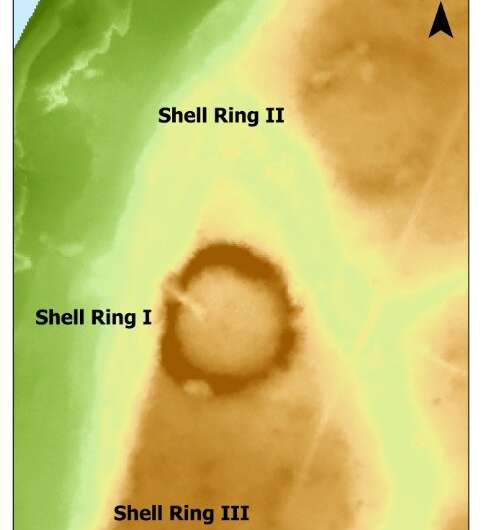Native American shell ring villages may have been occupied then abandoned because of climate change
MARCH 2, 2022
by Public Library of Science

LiDAR map showing the Sapelo Island Shell Ring Complex.
Credit: Carey J. Gar
Mollusk shells at 4,000-year-old Native American shell ring villages indicate that environmental change may have driven the formation and abandonment of these coastal communities, according to a study by Carey Garland and Victor Thompson in the open-access journal PLOS ONE on March 2, 2022.
Shell ring villages were coastal communities built around fishing, as indicated by their sitting next to shellfish estuaries, and their large mounds of mollusk shells which remain to this day. Shell rings formed some of the earliest human village settlements along the U.S. South Atlantic coast but were abandoned at the end of the Late Archaic around 4,000 years ago. While scholars have proposed socio-ecological explanations, there has been limited examination of the physical evidence for these.
Garland, Thompson and colleagues analyzed the biochemistry and paleobiology of mollusk shells found at three abandoned shell rings on Sapelo Island in Georgia, U.S. For example, they measured the size of oyster shells as an indicator of the health of the environment and compared oxygen isotope values to determine salinity conditions. They integrated their findings with chronological data—such as tree ring analyses—using a Bayesian chronological model, to determine environmental fluctuations over time.
The researchers found that the three Sapelo shell rings, known as Ring I, Ring II and Ring III, were occupied in the Late Archaic for varying, sometimes overlapping, periods. Ring II appeared to be the oldest and longest-lasting, founded around 4290 years ago and being occupied until 3950 years ago, with Ring I lasting around 150 years in the middle of this period. Ring III was the newest and outlasted the others, before abandonment around 3845 years ago. While Rings I and II featured large oyster shells, those at Ring III were significantly smaller, indicating a decrease in oyster shell size over time. Smaller oysters tend to be less healthy or younger, so this may indicate a depletion in oyster stocks and/or oyster health. Oxygen isotopes also indicated significantly lower salinity conditions by the time of Ring III as compared to Rings I and II.
More:
https://phys.org/news/2022-03-native-american-shell-villages-occupied.html
